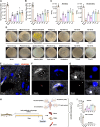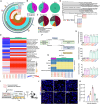A brain microbiome in salmonids at homeostasis
- PMID: 39292785
- PMCID: PMC11409976
- DOI: 10.1126/sciadv.ado0277
A brain microbiome in salmonids at homeostasis
Abstract
Ectotherms have peculiar relationships with microorganisms. For instance, bacteria are recovered from the blood and internal organs of healthy teleosts. However, the presence of microbial communities in the healthy teleost brain has not been proposed. Here, we report a living bacterial community in the brain of healthy salmonids with bacterial loads comparable to those of the spleen and 1000-fold lower than in the gut. Brain bacterial communities share >50% of their diversity with gut and blood bacterial communities. Using culturomics, we obtained 54 bacterial isolates from the brains of healthy trout. Comparative genomics suggests that brain bacteria may have adaptations for niche colonization and polyamine biosynthesis. In a natural system, Chinook salmon brain microbiomes shift from juveniles to reproductively mature adults. Our study redefines the physiological relationships between the brain and bacteria in teleosts. This symbiosis may endow salmonids with a direct mechanism to sense and respond to environmental microbes.
Figures





Similar articles
-
Correlating the oral swab microbial community with milk production metrics in Holstein dairy cows.mSphere. 2025 Jun 25;10(6):e0016725. doi: 10.1128/msphere.00167-25. Epub 2025 May 14. mSphere. 2025. PMID: 40366128 Free PMC article.
-
Integrated multi-omics analysis reveals the functional signature of microbes and metabolomics in pre-diabetes individuals.Microbiol Spectr. 2025 Jul;13(7):e0145924. doi: 10.1128/spectrum.01459-24. Epub 2025 Jun 9. Microbiol Spectr. 2025. PMID: 40488467 Free PMC article.
-
Characterizing the seminal microbiota in mature rams managed on divergent planes of nutrition, and their male offspring.J Anim Sci. 2025 Jan 4;103:skaf171. doi: 10.1093/jas/skaf171. J Anim Sci. 2025. PMID: 40371922
-
The Black Book of Psychotropic Dosing and Monitoring.Psychopharmacol Bull. 2024 Jul 8;54(3):8-59. Psychopharmacol Bull. 2024. PMID: 38993656 Free PMC article. Review.
-
Thrombolysis for acute ischaemic stroke.Cochrane Database Syst Rev. 2003;(3):CD000213. doi: 10.1002/14651858.CD000213. Cochrane Database Syst Rev. 2003. Update in: Cochrane Database Syst Rev. 2009 Oct 07;(4):CD000213. doi: 10.1002/14651858.CD000213.pub2. PMID: 12917889 Updated.
Cited by
-
Integrative systems biology approaches for analyzing microbiome dysbiosis and species interactions.Brief Bioinform. 2025 Jul 2;26(4):bbaf323. doi: 10.1093/bib/bbaf323. Brief Bioinform. 2025. PMID: 40619813 Free PMC article. Review.
-
The telencephalon is a neuronal substrate for systemic inflammatory responses in teleosts via polyamine metabolism.Proc Natl Acad Sci U S A. 2024 Sep 24;121(39):e2404781121. doi: 10.1073/pnas.2404781121. Epub 2024 Sep 16. Proc Natl Acad Sci U S A. 2024. PMID: 39284055 Free PMC article.
-
Expanding the use of circulating microbiome in fish: contrast between the gut and blood microbiome of Sebastes fasciatus.ISME Commun. 2025 Jul 11;5(1):ycaf116. doi: 10.1093/ismeco/ycaf116. eCollection 2025 Jan. ISME Commun. 2025. PMID: 40800616 Free PMC article.
-
Ensuring rigour of low-biomass microbiome research.Nat Microbiol. 2025 Feb;10(2):261-262. doi: 10.1038/s41564-025-01939-3. Nat Microbiol. 2025. PMID: 39905170 No abstract available.
References
-
- Cryan J. F., O’Riordan K. J., Cowan C. S., Sandhu K. V., Bastiaanssen T. F., Boehme M., Codagnone M. G., Cussotto S., Fulling C., Golubeva A. V., The microbiota-gut-brain axis. Physiol. Rev. 99, 1877–2013 (2019). - PubMed
-
- O’Riordan K. J., Collins M. K., Moloney G. M., Knox E. G., Aburto M. R., Fülling C., Morley S. J., Clarke G., Schellekens H., Cryan J. F., Short chain fatty acids: Microbial metabolites for gut-brain axis signalling. Mol. Cell. Endocrinol. 546, 111572 (2022). - PubMed
-
- Mohanta L., Das B. C., Patri M., Microbial communities modulating brain functioning and behaviors in zebrafish: A mechanistic approach. Microb. Pathog. 145, 104251 (2020). - PubMed
-
- R. D. Berg, Translocation of indigenous bacteria from the intestinal tract, in Human Intestinal Microflora in Health and Disease (Academic Press, 1983), chap. 15, pp. 333–352.
Publication types
MeSH terms
Substances
LinkOut - more resources
Full Text Sources

